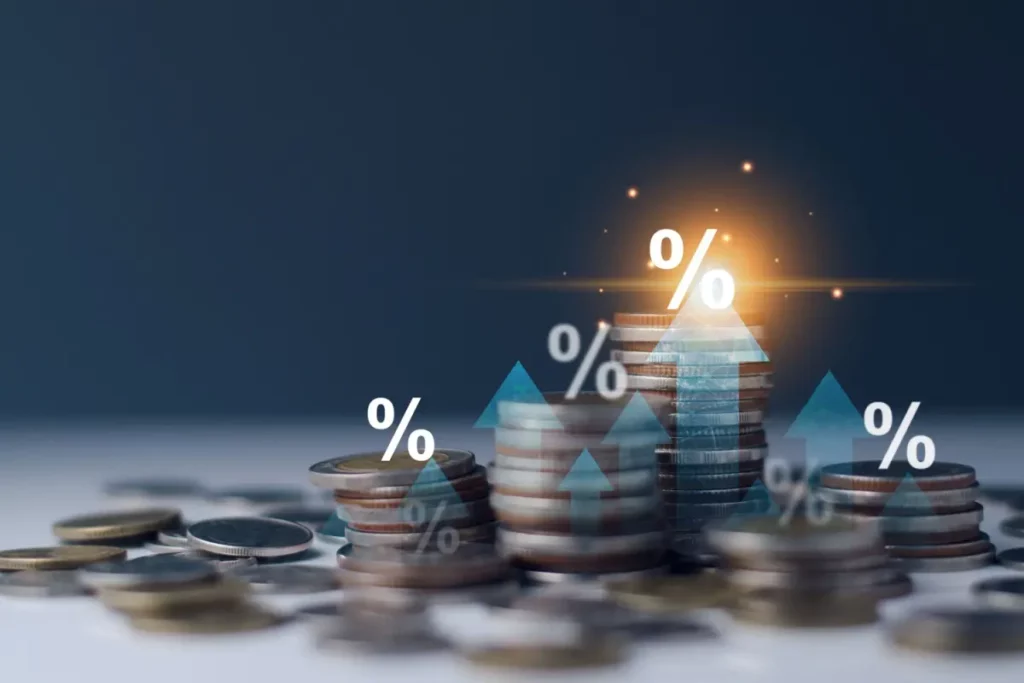You don’t need a business degree to understand how banks and interest rates work, as many people take out loans and eventually encounter this concept.
The interest rate is a percentage of the loan principal you pay back to the bank on top of the principal sum when you take out a loan. It is also the rate of return investors earn when they deposit their funds. It lies at the core of how banks and financial institutions function, so let’s better understand it below.
KEY TAKEAWAYS
- The interest rate is the difference between the amount the borrower pays to the lender and the amount the investor receives as income from investing their funds.
- Each country’s central bank determines the interest rates, analyzing economic factors like inflation, unemployment, and demand.
- Interest rates can be either simple or compound.
- The annual percentage rate (APR) represents the total interest amount, including hidden fees.
- Interest rates are closely tied to the economy and influence multiple factors, such as exchange rates and the housing market.
What Is an Interest Rate?
An interest rate is the percentage of the principal (the original amount) a lender charges a borrower for using their money. It also applies to the percentage earned on savings or investments.

When you take a loan from the bank, the bank also has to earn a profit. Otherwise, they wouldn’t do what they do. This profit is precisely why interest rates exist. The bank gives you the money you need to buy a house or open a new business and expects to get it back, plus a little extra for its services.
This is why interest rates exist and are paramount for banks to continue functioning. They are almost always applicable — from personal loans to credit cards and savings accounts to investment portfolios.
What Factors Determine the Interest Rate?
If you notice interest rates going up and down, it’s because the economy is driving them. Several economic factors determine interest rates. First, the central banks usually control all banks in their respective countries and dictate how much interest rates they can charge.
In the United States, the respective governing body is the Federal Reserve. While the Federal Reserve does not set the interest rates for all banks, it does set benchmarks that the banks use to determine their interest rates.
The Federal Reserve closely monitors several economic indicators to determine interest rates, some of which include:
- Inflation: When inflation increases, the central bank may raise interest rates to cool down the economy. Conversely, it might lower interest rates to encourage borrowing and spending when it goes down.
- Unemployment rate: When unemployment increases, the economy usually does poorly, so the central bank might lower interest rates to make borrowing more accessible to consumers.
- Gross domestic product (GDP): A country’s economy’s most used macroeconomic indicator. If it increases, interest rates tend to grow, too, and vice versa.
- Supply and demand: The basic principles of supply and demand also apply to interest rates. They tend to go up when demand is high and decrease when demand is low.
- Government debt: External government debt also influences interest rates, as governments issue bonds to make money. When government debt increases, interest rates also go up.
- International factors: Sometimes, global interest rates and economic conditions may also impact interest rates. For instance, if the United States increases its rates, other countries might follow to prevent capital outflow.
Types of Interest Rates
Interest rates typically come in two forms – simple and compound. Let’s look at how each of them works.
Simple Interest Rate
Simple interest rates are calculated based on the loan amount, rate, and term. They stay the same throughout the loan term and don’t consider previously accrued interest.
For instance, if you were to invest $50,000 for five years at a simple interest rate of 3%, here’s how much interest you would earn in total:
Interest = $50,000 * 3% * 5 = $7,500
If you divide it by 60 months (five years), your monthly earned interest amount would be $125. This number is constant and doesn’t change in the case of simple interest rates throughout the entire five years.
Compound Interest Rate
Unlike simple interest rates, compound interest rates use a slightly more complicated formula to calculate your total revenue. The rate can change and grow over time.
The general formula is: A = P (1 + r/n)^nt
P is the principal amount, r is the annual interest rate, n is the number of times interest is compounded each year, and t is the number of years you invest your money.
For example, if you invest the same $50,000 at a 3% for five years, but this time compounded annually, the total money you will earn at the end would be:
A = $50,000 * (1 + 0.03/1)^(1*5) = $57,963
Therefore, the total interest earned would be:
Interest = $57,963 – $50,000 = $7,963
As you can see, this method has yielded higher income than the simple interest rate. Compound interest can also be compounded more frequently than annually, earning even more interest. Seeing the effect of compounding is usually more beneficial for long-term investments.
What is an APR?
Put simply, the annual percentage rate (APR) is the annual interest rate for your borrowed money. Unlike simply defining the rate as the “interest rate,” the APR also considers additional fees and costs associated with borrowing. These fees might include loan origination fees, administration fees, and underwriting, usually not reflected in the interest rate.

As a result, it gives a more comprehensive view of the total amount you owe. It is also useful for comparing different loan products. In many regulations, lenders are required to disclose their APRs besides just stating the interest rate, as customers need to be aware of any additional fees and costs before buying certain loan products.
The Role of Interest Rates in the Economy
Interest rates are one of the driving forces of the local and global economy. Firstly, because they directly affect how much consumers can borrow, they give a snapshot of the housing market’s situation and other industries at a given time. Next, businesses rely on interest rates to fund capital investments, expand operations, and manage cash flows.
Additionally, interest rates impact exchange rates. Higher interest rates often indicate that a specific country offers higher yields, strengthening the country’s currency.
And finally, interest rates also affect the housing market, as they influence mortgage rates. Moreover, when interest rates are low, it’s cheaper for the government to issue debt to fund its operations and invest in infrastructure projects, which can stimulate the economy.
FAQ
What Is the Interest Rate in Simple Words?
An interest rate is the cost of borrowing money or the return on money saved or invested, expressed as a percentage of the total amount. It is the sum you pay to your creditor for their service and the sum the investor receives for it.
What Happens When Interest Rates Rise?
When interest rates are high, borrowing money costs more. On the other hand, it becomes more attractive for investors and savers, as they can potentially yield higher returns.
High interest rates can also negatively impact the overall economy and the stock market, as it becomes more difficult for companies to borrow money.
Is a High Interest Rate Good or Bad?
It depends on which side you look at it. For borrowers, it’s usually bad for their finances, as it means the loan product is more expensive to them. But if you’re a saver or an investor, this is generally good news, as you may see higher returns on savings accounts, bonds, or other investments.
What Does a 4% Interest Rate Mean?
If you’re a borrower, this generally means that your loan requires you to pay 4% of the principal as interest each year. However, how much you repay depends on the loan term and whether the interest is compounded or simple.
If you are an investor, the 4% interest rate might mean you earn 4% annually. However, if your investment compounds, your return will be higher.